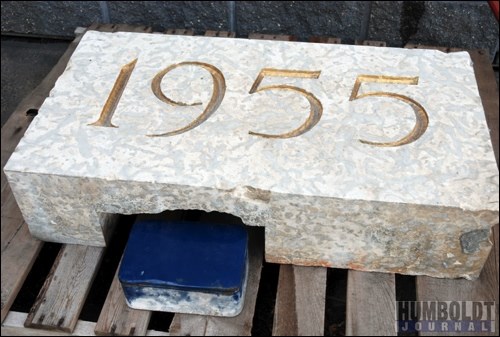In trying to preserve one piece of history, another was uncovered.
A time capsule was recently discovered when maintenance crews were removing the cornerstone from the old Humboldt District Hospital (HDH) building, formerly known as St. Elizabeth's Hospital.
The crew were taking a few items from the old hospital - things like the cornerstone and a cross - from the exterior of the building to preserve them for the future.
The HDH moved into its new space in the Humboldt District Health Complex in April.
But when they removed the cornerstone - a large stone bearing the date the building was constructed, 1955 - from its place in the wall to the left of the main entrance doors - they found a metal box in a little carved out niche behind the large stone.
"Maintenance was very excited," said HDH site manager Yvonne Berscheid about the discovery.
The small metal box turned out to be a time capsule, sealed in the cornerstone when the new hospital building opened in 1955.
Hospital administration had no idea a time capsule was located behind the cornerstone, but it seems at least one of the Sisters of St. Elizabeth knew something would likely be there.
"I didn't know what was in it," said Sr. Philomena Dobmeier, of the Order of St. Elizabeth, when she examined the contents of the box in Berscheid's office of the new hospital last week. "But I knew it was a cornerstone, and that others always had something put behind it."
Inside the small metal box, they found a handful of items, including a written history of St. Elizabeth's Hospital dated August 2, 1955.
"The introduction is very good," remarked Dobmeier when she examined the document.
That introduction states: "On the occasion of the erection of the new St. Elizabeth's Hospital here at Humboldt, Saskatchewan, it seems appropriate that a short history covering the growth and development of the hospital, be sealed in the corner stone, as a link between past and the future. To you who may some day see this record, we extend greetings from the past. We wish you God's blessings for the future ahead of you and hope that this record may be of interest and value to your generation. May we bespeak indulgence for our failings and your prayers for our souls."
The document goes on to explain the hospital at that time was run by the Sisters of St. Elizabeth of the Third Order Regular of St. Francis of Assisi, and tells the story of how the first Sisters arrived in the area in 1911. It notes that the first hospital was constructed in 1912 - a two-storey structure 54 by 52 feet with a full basement, kitchen, store rooms, chapel, operating room, beds for 18 patients, and quarters for the Sisters above the second floor - and that it cost $25,000 to build.
It details the first patients of the hospital, admitted in 1912, and the number of patients cared for in the years of its operation.
"Records show that a total of 70,843 patients were admitted as of December 31, 1954 - not including outpatients," it states. "This same date shows a total of 8,544 births."
Their plans for a new hospital were finally approved by the Provincial government on September 5, 1952, when they dropped the number of desired beds from 125 to 100, and finally to 75.
Construction of the new building began in May 1953, after the soil was blessed and the first sod officially turned by Mayor Laskin of Humboldt.
For two years, workers constructed the hospital, from bricklaying to installing terrazzo floors. The building was estimated to cost $805,000 - a cost that was split between the provincial government, local municipalities and donations - the same three entities, virtually, who covered the cost of the new HDHC.
The document was likely written by the administrative group of Sisters who ran both the hospital and the convent at that time. Their names are listed at the end of the history.
None are still with us today, Dobmeier noted, so it truly is a message from the past.
A few other items were also found in the time capsule: German currency, both paper and coin; religious relics, including a small envelope marked "Rose powder from the grave of St. Francis" and religious medals of various types.
The medals are things that the Sisters habitually include, Dobmeier noted.
They included medals of St. Francis of Assisi and St. Elizabeth of Hungary, their patron saints; St. Christopher, Pope Pius XII, Our Lady of Immaculate Conception, St. Augustine, St. Joseph and St. Claire of Assisi.
The contents of the time capsule will be donated to the Humboldt and District Museum and Gallery, Berscheid indicated, so that they will be further preserved.
The discovery of this small tin box has inspired the present staff at the hospital to make a time capsule of their own.
This fall, Berscheid plans to ask the staff what they think would be appropriate to include, what they would like future generations to remember them by.
"We'll work on some type of contests for the fall, and install a cornerstone in some location," she said.
What will happen to the 1955 cornerstone has yet to be determined. Cornerstones from other buildings belonging to the Sisters have been installed on the grounds of their convent.
They will ensure, Berscheid noted, that the history of that building is honoured, wherever the stone is placed.




